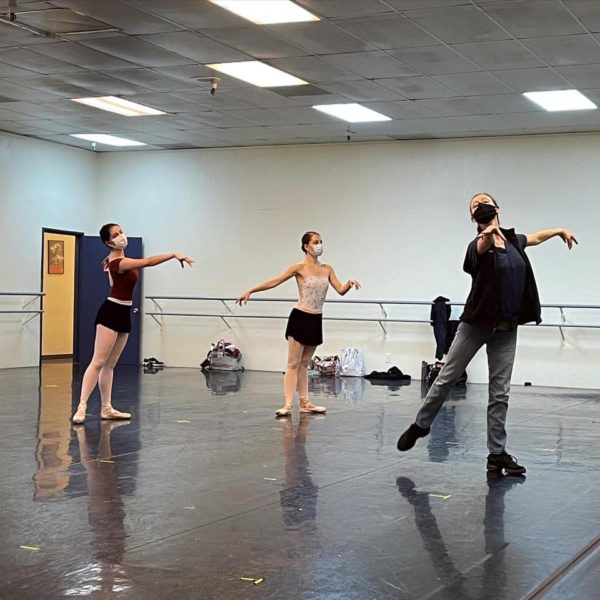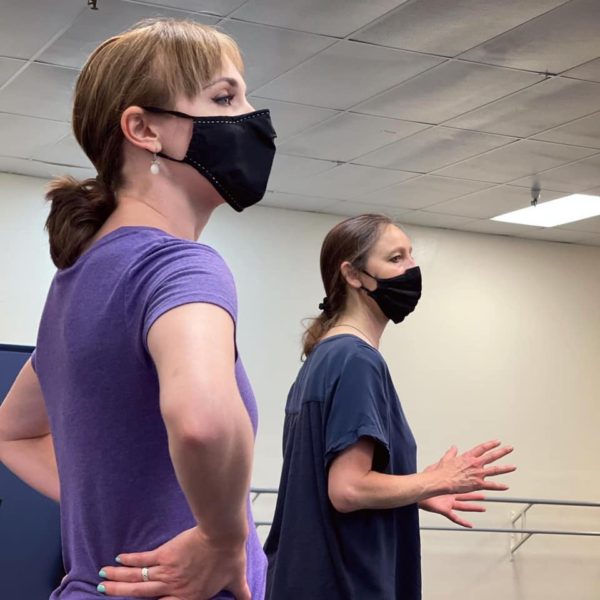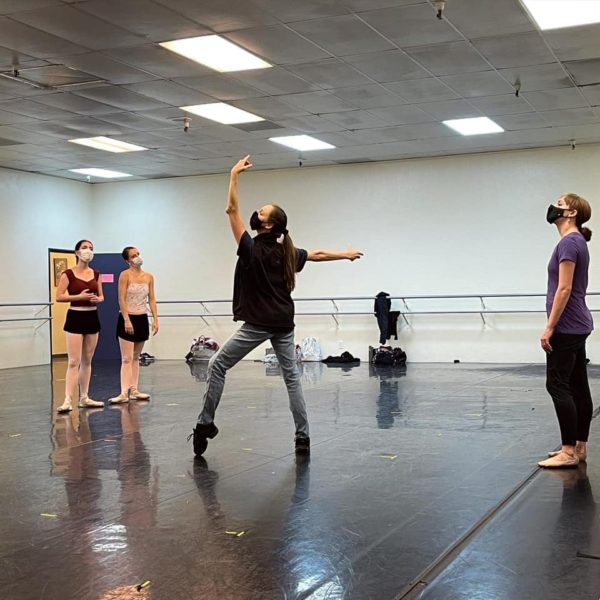Q&A with the Footprints at the Fox Choreographers
Comments Off on Q&A with the Footprints at the Fox Choreographers By: Mallory CashGet to know our Footprints at the Fox choreographers (in the order their pieces will appear onstage) in this Q&A by Ballet Tucson Brady Fellow Mallory Cash!
Skylar Burson
Piece Title: Eloquence

Q: If you had to describe your piece in three words, what would they be?
A: Graceful, Strong, and Enjoyable.
Q: What inspired you to create your piece?
A: The opportunity, the music, and my passion for the artform inspired me to create this piece.
Q. How has the choreographic and rehearsal process been?
A: The choreographic and rehearsal processes have been good learning experiences that have taught me to allow for flexibility within my concepts and choreography.
Q: What do you hope the audience takes away from your piece?
A: I hope the audience feels a sense of joy while watching dancers do what they love on stage.
Q: What has been your favorite part about choreographing?
A: My favorite part of choreographing is being able to express ideas, concepts or feelings through movement.
Audrey McGonagle
Piece Title: Ostinato in Blue

Q: If you had to describe your piece in three words, what would they be?
A: Busy, spontaneous, and periodic
Q: What inspired you to create your piece?
A: The piece is inspired by the use of repetition in the music. Every dancer is assigned to one of the unique rhythmic phrases that are introduced throughout the piece.
Q. How has the choreographic and rehearsal process been?
A: The choreographic process has been an incredible learning experience! My dancers are extremely hard working individuals and I have really loved working with such passionate artists.
Q: What do you hope the audience takes away from your piece?
A: I admire art that welcomes and encourages the development of multiple viewpoints. I hope audience members will feel a unique connection to this piece and create their own perspective of what it means to them.
Q: What has been your favorite part about choreographing?
A: I really love collaborating with my dancers and watching the piece evolve as we move along. It’s been a really fun experience watching my dancers translate my ideas into movements and build off from the initial structure.
Kelsey Minzenmayer
Piece Title: Never Be Without

Q: If you had to describe your piece in three words, what would they be?
A: ethereal, connective, and ambient
Q: What inspired you to create your piece?
A: My inspiration for this piece was greatly influenced by the music as well as how the world has been impacted since Covid-19. After not being able to dance for over a year, I was beyond excited to create something that would be so joyous to dance and I’m thrilled to get to share that experience with the dancers and the audience.
Q. How has the choreographic and rehearsal process been?
A: The choreographic and rehearsal process has all around been so positive. As every artist does, I definitely had a few challenges I faced with creating my piece. Along with experiencing some mental block, I had 2 weeks of crucial creative time taken away at the beginning of the process since I couldn’t be there due to being sick. Overall the dancers, music, and movement all worked together in the end and I think the piece was created how it was meant to be.
Q: What do you hope the audience takes away from your piece?
A: Since I was inspired to create the piece by the music, my main goal was for the audience to see the music through dance. I hope they can take away the music’s serene, meditative textures through the movement.
Q: What has been your favorite part about choreographing?
A: The best part of choreographing has been working with the dancers in the studio and being able to create movement together that looked effortless by using their natural movement.
Kendra Clyde
Piece Title: Phases

Q: If you had to describe your piece in three words, what would they be?
A: childhood, rebellion, trials
Q: What inspired you to create your piece?
A: A lot of things inspired this piece, but it’s a lot of experiences I’ve had in my own life and what I’ve analyzed in other people’s lives. My piece is about growing up and how some of the experiences people have cause them to go through a rebellious phase. I think a lot of people go through those stages in life at different points and I’m trying to capture that in dance.
Q. How has the choreographic and rehearsal process been?
A: I have to say it’s been so fun. It’s so amazing that this is our job, to create and I do a lot of experimenting in my rehearsals. I do a lot of improv because I like to see how my dancers move and I also want to incorporate their feelings and emotions to the movement.
Q: What do you hope the audience takes away from your piece?
A: I want them to reflect on their own life. I want them to remember what they did as a kid and I want the audience to remember, “oh yeah, when I went through my Rebellion phase this is what I did or or oh yes, I did go through some trials, but I’m okay now.”
Q: What has been your favorite part about choreographing?
A: The dancers and getting to know them. We even discuss some of the experiences we’ve had in our own life to incorporate into the movement. I feel honored that they tell me about their lives and they work so hard. It wouldn’t be the same dance without them.
Casey Johnson
Piece Title: Intrepid

Q: If you had to describe your piece in three words, what would they be?
A: Sensual, dimensional, ornate
Q: What inspired you to create your piece?
A: My piece was inspired by a sunset one evening as I was listening to this music, and I looked up and kind of had this idea of the moon and sun having this intimate moment together.
Q. How has the choreographic and rehearsal process been?
A: The choreographic and rehearsal process has been a whirlwind this year, but the end result from the process ended up being something really satisfying.
Q: What do you hope the audience takes away from your piece?
A: I hope they take away a sense of excitement and passion after seeing this work.
Q: What has been your favorite part about choreographing?
A: My favorite part of choreographing is getting to see the finished product, and watching the dancers tell a story with it.
Tim Kolman
Piece Title: Heracles

Q: If you had to describe your piece in three words, what would they be?
A: Nostalgic. Epic. Fantasy.
Q: What inspired you to create your piece?
A: I wanted to see what I was capable of. I did it to see if I could rise to the challenge of using complicated music and give off the correct feelings of the piece to the audience.
Q. How has the choreographic and rehearsal process been?
A: The process has been very fast and encouraging for both me and the dancers. Each rehearsal, the piece has made enormous progress and therefore our confidence grew.
Q: What do you hope the audience takes away from your piece?
A: Just to be taken away from their realities and become a part of a nostalgic experience. Just for a moment.
Q: What has been your favorite part about choreographing?
A: Seeing myself create something on the spot that works well with the music and watching the dancers create their own characters in the piece to make it all come alive.
Q: If you had to describe your piece in three words, what would they be?
A: Nostalgic. Epic. Fantasy.
Q: What inspired you to create your piece?
A: I wanted to see what I was capable of. I did it to see if I could rise to the challenge of using complicated music and give off the correct feelings of the piece to the audience.
Q. How has the choreographic and rehearsal process been?
A: The process has been very fast and encouraging for both me and the dancers. Each rehearsal, the piece has made enormous progress and therefore our confidence grew.
Q: What do you hope the audience takes away from your piece?
A: Just to be taken away from their realities and become a part of a nostalgic experience. Just for a moment.
Q: What has been your favorite part about choreographing?
A: Seeing myself create something on the spot that works well with the music and watching the dancers create their own characters in the piece to make it all come alive.
Francesca Poznanski
Piece Title: Grey Matter

Q: If you had to describe your piece in three words, what would they be?
A: Intentional, slightly chaotic, and corresponding
Q: What inspired you to create your piece?
A: I listened to the music and I pictured different people and the way they communicate with one another and translate information. The formation of what happens in the brain and how you have different motor skills that translate information. Those pieces of your brain are actually called grey matter.
Q. How has the choreographic and rehearsal process been?
A: It’s the first time I’ve choreographed a piece so it’s definitely new and different from setting a piece. To have to come up with everything and not only set it on people, but also figure out by myself how to create different things with specific timing.
Q: What do you hope the audience takes away from your piece?
A: I hope it shows different relationships and how they influence you in different aspects of your life, along with how important each and every person is, even if some things don’t suit your personality perfectly.
Q: What has been your favorite part about choreographing?
A: Getting to be a part of something I’ve never done before and working in such a professional environment, creating something that comes straight from me and is molded on the dancers.
Brik Middlekauff
Piece Title: Assemble

Q: If you had to describe your piece in three words, what would they be?
A: Demanding, exuberant, dynamic
Q: What inspired you to create your piece?
A: The music inspired my piece.
Q. How has the choreographic and rehearsal process been?
A: I really enjoyed the choreographic and rehearsal process. I learned a lot about myself as a first time choreographer and appreciated my cast being so adaptable.
Q: What do you hope the audience takes away from your piece?
A: I hope the audience feels joyful throughout my piece.
Q: What has been your favorite part about choreographing?
A: I loved being in the studio with the dancers and seeing them bring my vision to life.
DeVonte’ Tasker
Piece Title: Don’t Wait For Me

Q: If you had to describe your piece in three words, what would they be?
A: Very chill ballet
Q: What inspired you to create your piece?
A: I was working with music from a friend of mine and the songs talk about a complicated relationship, and I wanted to tell an even more complicated story than what was already in the songs. I thought I would try telling a story of four people liking the same person, so it’s a complex love story.
Q. How has the choreographic and rehearsal process been?
A: It’s been super easy honestly. I choreographed 5 of the minutes beforehand so I had half of it done prior to coming into the studio, and the other parts were easy to set since we had ideas to work with already. The dancers are also super easy to work with.
Q: What has been your favorite part about choreographing?
A: Honestly, creating a 10 minute piece has been the most challenging, but also the most fun. We had to have a time limit, so meeting that but making sure it’s something that I am comfortable with has been interesting (since I’ve never choreographed a piece longer than five minutes), so I’m excited about it.
Danielle Cesanek
Piece Title: Noir

Q: If you had to describe your piece in three words, what would they be?
A: feminine, dark, and slow
Q: What inspired you to create your piece?
A: I was inspired by the low, emotional sounds of the cello to create a piece around women and their strength and sorrows.
Q. How has the choreographic and rehearsal process been?
A: This rehearsal process was actually a bit more challenging than the past few Choreolab experiences. I was trying to challenge myself by choreographing something out of my comfort zone. I wanted to go for a slower, darker, more grounded piece instead of my usual bright, fast, happy choreography.
Q: What do you hope the audience takes away from your piece?
A: I hope the audience can feel the beauty of the music through the dancers.
Q: What has been your favorite part about choreographing?
A: The best part about choreographing is the ability to change things that might not work as you initially envisioned them to. I love that I can come into the studio and switch something that I didn’t love or alter a step to really showcase a dancer’s strengths.



